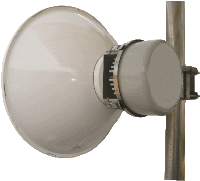
SparkWave is optimized for different propagation conditions in different weather conditions. In many cases, spectrum economy plays a major role in considerably reducing operating costs.
 The equipment SparkWave series has different outdoor and indoor radio relay units. SparkWave SDR indoor unit is modular. Different housings and high integration level allow easy interconnection, stacking with ESSI interface and direct connection to existent F/O networks. Outdoor units (ODU) is connected to the IDU via single coaxial cable up to 400 m. The outdoor units are connected to antennas using waveguide up to 1.8 m.
The equipment SparkWave series has different outdoor and indoor radio relay units. SparkWave SDR indoor unit is modular. Different housings and high integration level allow easy interconnection, stacking with ESSI interface and direct connection to existent F/O networks. Outdoor units (ODU) is connected to the IDU via single coaxial cable up to 400 m. The outdoor units are connected to antennas using waveguide up to 1.8 m. The SparkWave SDR HSP is intended for microwave transmission of PDH and Ethernet signals, operating in 5, 6, 7, 8, 11, 13, 15, 18, 23 and 26 GHz frequency range.
Split Mount solution with High Speed PDH (HSP) IDU and compact ODU. Any combination of E1, E3 and Ethernet signals is possible. The upper transmission capacity limit is 152 Mb/s or 72xE1 equivalent. Various transmission modes from 4QAM to 128QAM with different error correction schemes enable signal transmission in various channel bandwidth from 3,5 MHz to 28 MHz according to customer demands.
A management system with an SNMP agent and OSPF router is built into the unit. No additional equipment is needed except a standard personal computer with built-in web browser.
| Frequency plan | 5,6,7,8GHz | 11 GHz | 13 GHz | 15 GHz | 18 GHz | 23 GHz | 26 GHz | |
| RF output power on antenna connector, dBm | 4QAM 16/32QAM 64/128QAM |
26/30 24/28 22/26 |
26/31 23/28 21/26 |
24 22 20 |
24 22 20 |
23 21 19 |
22 20 18 |
22 20 18 |
| Channel spacing, MHz | 3,5/7/ 14/28 |
14/28 | 3,5/7/14/28 | 13,75/ 27,5 |
3,5/7/14/28 | |||
| Frequency stability | ± 5х10-6 | |||||||
| Frequency seeting step | 0,25 MHz | |||||||
| ATPC output power adjusting range | 20 dB in 1 dB step | |||||||
| Receiver treshold at antenna connector in dBm for BERR=10-6 |
modulation/BW 4QAM 16QAM 32QAM 64QAM 128QAM |
3,5 MHz 7 MHz 14 MHz 28 MHz - -86 -88 -87 -82 -86 -83 -80 -85 -82 -78 -76 - - -74 - - - -72 -69 |
||||||
| Link protection modes | Hot Stand-By, Space Diversity, Frequency Diversity, Hitless switch | |||||||
| Transmission capacity, given by N x E1 without FEC | modulation/BW 4QAM 16QAM 32QAM 64QAM 128QAM
|
3,5 MHz 7 MHz 14 MHz 28 MHz - 4 - 5 7 - 11 15 - 22 4 7 - 8 15 - 18 30 - 39 4 - 5 9 - 11 19 - 24 40 - 50 - - 27 - - - 30 - 36 68 - 72 * In the case of link protection 2U chassis is necessary; * E3: every E3 occupies 17 x N (N is the number of equivalent E1 channels); * Ethernet: transmission capacity is: 2092 kb/s x N (N is the number of equivalent E1 channels) |
||||||
| Trafic interface | PDH interface ITU-T recommendations bit rate |
E1 G.703 point 6 2048 kb/s |
E3 G.703 point 8 34368 kb/s |
|||||
| Ethernet interface | 10Base-T/100 Base-Tx adaptive; compatibility IEEE 802.3 half duplex and full duplex; IEEE 802.3 management statistics (RMON); IEEE 802.3u auto-negotiation; connector type RJ45, Automatic connection MDI/MDIX; number of interfaces on central module 2. |
|||||||
| E1 wayside channel | ITU-T recommendations bit rate (plesiochronous) multiplexing principle |
G.703 point 6 2.048 kb/s RSOH and MSOH bytes |
||||||
| Other interface | management interface service channel interface |
10Base-T / 100Base-Tx адаптируемый; 10Base-T / 100Base-Tx адаптируемый; |
||||||
| Mechanical / Environmental | operation climatic conditions (temp./humidity.) |
indoor unit (IDU) -5°С...+45°С/8...95% ETSI EN 300 019 class 3.1Е outdoor unit (ODU) -33°С...+50°С/5...100% ETSI EN 300 019 class 4.1Е (-50°С...+50°С option) |
||||||
| storage/transport conditions | ETSI EN 300 019 class 1.1 / class 2.3 | |||||||
| EMC compatibility | ETSI 301 489-4 | |||||||
| power supply | from 20V to 72V ETSI EN 300 132 | |||||||
| power consumption IDU power consumption ODU |
<19 W - 1U, <39 W - 2U <25 W |
|||||||
| dimensions (H x W x D) IDU dimensions (H x W x D) ODU |
45 х 442 х 240 mm - 1U; 86 x 442 x 240 mm - 2U 200 х 150 х 80 / F305 x 120 |
|||||||
| weight IDU weight ODU |
3,17 kg - 1U; 5,96 kg - 2U <6 kg |
|||||||

